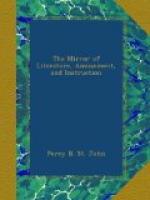out of Mount Misery, it is difficult to decide.
That the low lands have been thrown from the mouth
of the volcano is evident, from the regular strata
of volcanic substances of which they consist; these
too are interspersed with masses of volcanic rock,
and other stones, some of the lesser ones entirely
roasted through, and some of the larger ones to certain
depths from their surfaces. Masses, also, of
iron-clay, enclosing various pebbles, which have been
burnt into a kind of red brick, are abundantly found
in many places. There is scarcely any thing that
can be called a path, or even a track, to the mouth
of the crater of Mount Misery; indeed, there are but
few whose curiosity is sufficiently strong to induce
them to undertake this expedition. The common
course for those who do, is to take a negro man as
a guide, with a cutlass, or large knife, to clear
away the underwood, and form a kind of path as he goes
on. The ascent is very irregular, in some places
being gentle, in others almost perpendicular; in which
case the hands are obliged to assist the operations
of the feet. In wet weather, the ascent of this
mountain is extremely laborious, as a great part of
it consists of clay, which then becomes so slippery
as to render the getting up almost impracticable.
About half-way up on the south side, and in a very
pretty, romantic situation, there is a natural spring
of remarkably cool water. On the north side, at
about the same height, there is a waterfall, which,
though small and insignificant in itself, has a pleasing
appearance, as it rushes over the rocks, and through
the trees and shrubs. This mountain is thickly
clothed with wood, which in many places not only excludes
the rays of the sun, but produces a sombre, gloomy
appearance; this, with the occasional plaintive coo
of the mountain dove, (the only sound heard at this
height,) creates in the mind sensations of pleasing
melancholy. In some parts an open space suddenly
appears, from whence the whole country below bursts
unexpectedly upon the view, which has, as may be supposed,
an extremely fine effect. The thermometer, on
the top of the mountain when the writer visited it,
stood at 65, being a difference of 15 degrees from
the low lands, where it stood at 80 degrees.
The descent into the crater on the north and east sides
is perfectly perpendicular; on the south and west
sides, it slopes at an average angle of not more than
18 or 20 degrees from the perpendicular; consequently,
persons descending are often obliged to let themselves
down by clinging to projecting corners of rocks, or
the branches and roots of shrubs, which grow all the
way down; nor is this mode of travelling particularly
safe, for should any of these give way, the consequence
would probably be highly dangerous. The bottom
of the crater, which, as nearly as could be estimated,
is about 2,500 feet below the summit of the mountain,
and contains about forty-five or fifty acres, may
be said to be divided into three parts: the lowest




